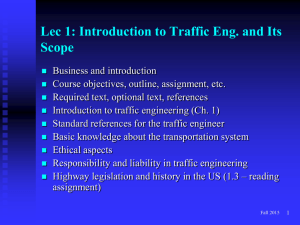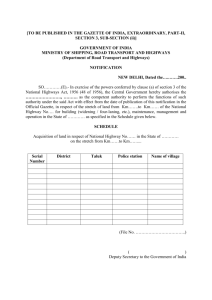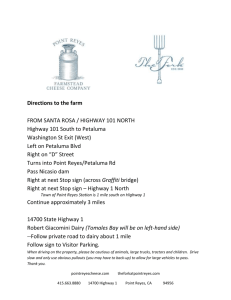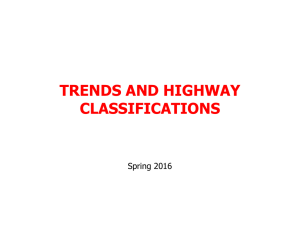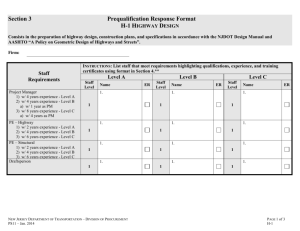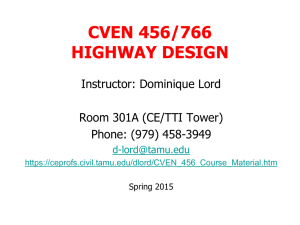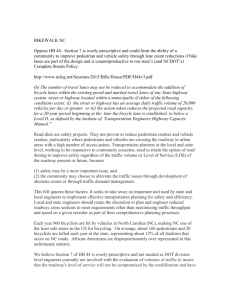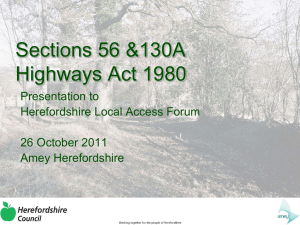Traffic Engineering Introduction & Scope - Lecture 1
advertisement
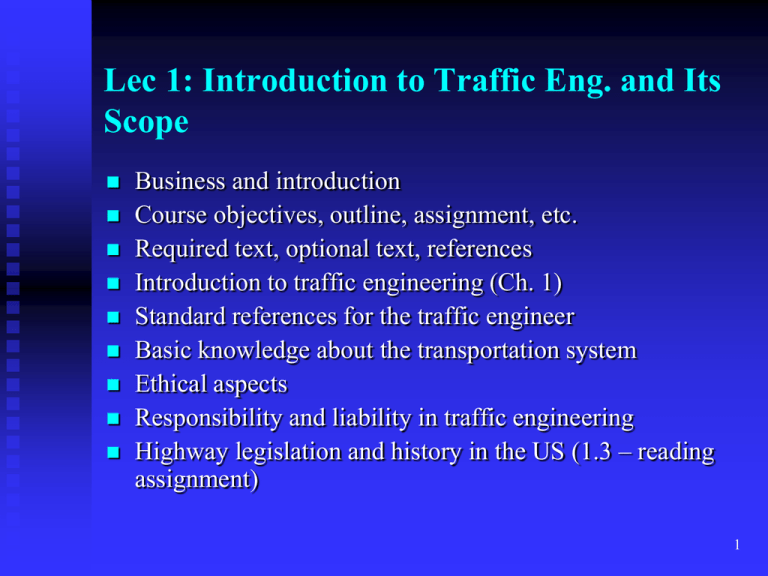
Lec 1: Introduction to Traffic Eng. and Its Scope Business and introduction Course objectives, outline, assignment, etc. Required text, optional text, references Introduction to traffic engineering (Ch. 1) Standard references for the traffic engineer Basic knowledge about the transportation system Ethical aspects Responsibility and liability in traffic engineering Highway legislation and history in the US (1.3 – reading assignment) 1 Business and Introduction Instructor’s background Students’ introduction CE562 Learning Suite website Printing in Room 234CB – You must have a signature account Rules for using reference materials (please check the Text page of the website for the location where they are available and check out duration) No surfing the web or do something else with the computers during lectures – keyboard noise is distractive to other students. TA , TA hours, and TA room 2 The Structure of the Textbook Introduction Introduction (Ch 1) Traffic Components and Characteristics (Ch 2-6) The Intersection (Ch 18-30) Freeways and Rural Highways (Ch 13-17) Traffic Studies and Programs (Ch 7-12) 3 Course schedule & midterm dates: Visit CE En 562 Learning Suite website. Term paper and term project: Found in the Content section of the course website. 4 1.1 Transportation Engineering (ITE) “ Transportation Engineering is the application of technology and scientific principles to the planning, functional design, operation, and management of facilities for any mode of transportation in order to provide for the safe, rapid, comfortable, convenient, economical, and environmentally compatible movement of people and goods” (p.1) 5 Traffic Engineering (ITE) “The phase of transportation engineering that deals with the planning, geometric design and traffic operations of roads, streets and highways, their networks, terminals, abutting lands, and relationships with other modes of transportation.” (P.1) 6 Objectives of traffic engineering Safety is the primary objective – More than 40,000 people die each year in traffic accidents (33,561 in year 2012) Speed (Higher speed means shorter travel time. Interstate highways encourage long distance trips.) Comfort – Involves the physical characteristics of vehicles and roadways Convenience – The ease of making trips and the ability of transport systems to accommodate all travel needs Economy – Try to provide the best possible systems for the money Environmental compatibility – Provide sustainable transport systems 7 Ethical Aspects – traffic engineers deal with the public as well as engineering topics Be honest Avoid “cutting corners” Avoid tailoring the results to please the client Avoid manipulating data Know what’s in the analysis models and software Engineers Code of Ethics (example) 8 Responsibility & Liability We deal with people and goods. Safety is the utmost importance in this profession. Provide for the public safety through positive programs, good practice, knowledge, and proper procedure. Tort liability – Public agencies may be sued for negligence Avoid liability problems [Read the right column, page 2] 9 1.4 Elements of traffic engineering Traffic studies and characteristics Performance evaluation Facility design Traffic control Traffic operations Transportation systems management Integration of ITS technologies 10 1.2 Transportation Systems and their Function “Transportation systems are a major component of the U.S. economy and have an enormous impact on the shape of the society and the efficiency of the economy in general.” 11 (For year 2009 stats click the link.) http://www-fars.nhtsa.dot.gov/Main/index.aspx http://en.wikipedia.org/wiki/List_of_countries_by_traffic-related_death_rate http://en.wikipedia.org/wiki/List_of_countries_by_population 12 Figure 1.1 Public Highway Mileage and Annual Vehicle-Miles Traveled in the United States, 1920–2007 (Source: Highway Statistics 2007, Federal Highway Administration, U.S. Department of Transportation, Washington DC, 2008, Table VMT 421.) 13 1.2.1 The Nature of Transportation Demand “This circular, self-reinforcing characteristics of traffic demand creates a central dilemma: building additional transportation capacity invariably leads to incrementally increased travel demands. (p.5, 1st paragraph)” Intelligent transportation systems & Intermodal systems 14 1.2.2 Concept of Mobility and Accessibility Principal arterials Mobility Minor arterials Major collectors Access Minor collectors Local roads and streets Mobility = the ability to travel to many different destinations Accessibility = the ability to gain entry to a particular site or area 15 1.2.4 Transportation Modes 16 Intermodal system for freight (North Salt Lake UP Transfer Yard) 17 Attention to intermodalism Front of DB Station, Ulm, Germany Tram-bus transfer, Cologne, Germany Unimodal Bimodal Multimodal Intermodal 18 Intermodal transportation system in our area (SLC Intermodal Hub) 19 Amenities of the Frontrunner 20 1.3 Highway Legislation & History Read the textbook section 1.3 and become acquainted with key legislative milestones in the US. The National Highway System: http://www.fhwa.dot.gov/planning/nhs/ See ISTEA and TEA-21 in page 11. Then, SAFETEA-LU. And now MAP-21 (Moving Ahead for Progress in the 21st Century). 21 The Interstate System 42,500 miles 22 NHS 160,000 miles 23 24 1.5 Modern Problems for the TE Urban congestion Growth management Reconstruction of existing highway facilities maintenance of traffic is a major issue Security of transportation facilities since 9/11. 25 1.6 Standard References for the Traffic Engineer Uniform Vehicle Code (UVC) and Model Traffic Ordinance Manual of Uniform Traffic Control Devices (MUTCD 2003, 2009) (on-line) Highway Capacity Manual (HCM) AASHTO’s Green Book – A Policy on Geometric Design of Highways and Streets Traffic Engineering Handbook Manual of Traffic Engineering Studies (on-line) Trip Generation by ITE 26
